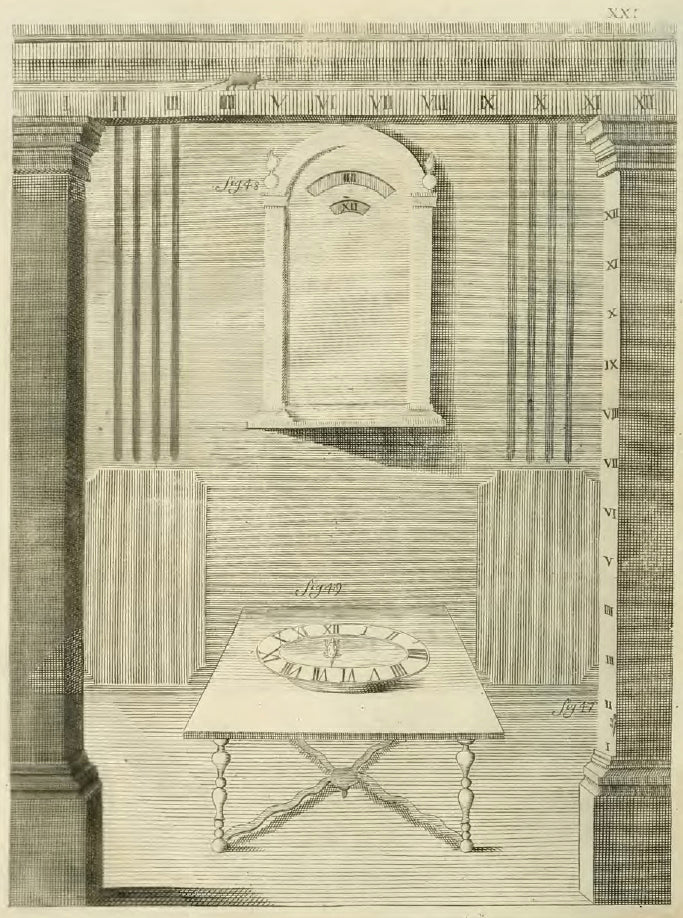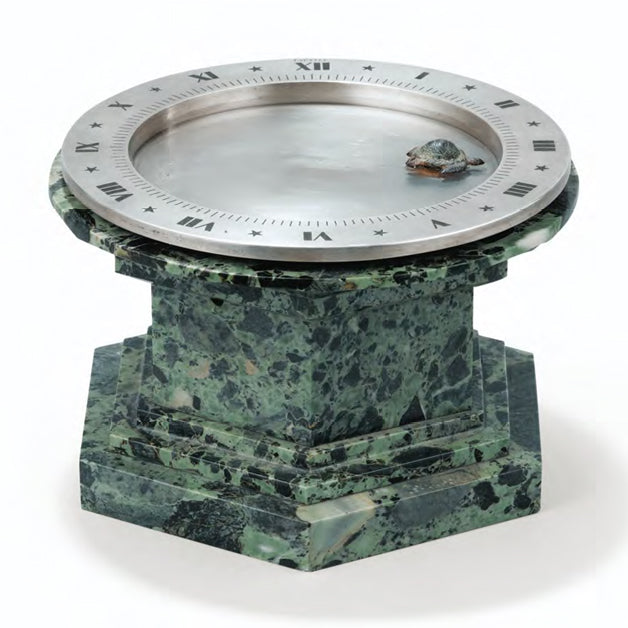
A detail of the a desk clock in the form of a bowl with a floating turtle pointing to the hour. This sixteenth-century design inspired the Cartier magnetic turtle clock.

A page from Recueil d’Ouvrages Curieux de Mathématique et de Mécanique, ou Description du Cabinet de Monsieur Grollier de Servière, 1751, depicting several fantastic clock concepts from the sixteenth century by Nicolas Grollier de Servière.
THE BOUTET DE MONVEL MYSTERY CLOCK: AN ART DECO FLOATING TURTLE MYSTERY CLOCK BY CARTIER, PARIS, CIRCA 1927
THE BOUTET DE MONVEL MYSTERY CLOCK: AN ART DECO FLOATING TURTLE MYSTERY CLOCK BY CARTIER, PARIS, CIRCA 1927
SOLD: Acquired by the Cartier Collection
A clock composed of a hexagonal marble base in the shape of a column surmounted by a sterling silver dish engraved and black enameled with the hours and minutes at the edges, when filled with water, a turtle with concealed iron implant floats and indicates the time set by a magnet concealed at the side; 7 jewels, 2 adjustments, movement in brass and steel, numbered 114825, Geneva Clock Co., Swiss
- Dial signed Cartier, signed and numbered European Watch & Clock Co, 13041
- 5 5/8 × 7 3/8 inches
Additional cataloguing
Provenance
- Bernard Boutet de Monvel
Literature
- cf. Chaille, François, and Franco Cologni. The Cartier Collection: Timepieces. Paris: Flammarion, 2006 pp. 312–15.
- cf. Nadelhoffer. Cartier. San Francisco: Chronicle Books, 2007, p. 271.
Biography
Cartier was founded in Paris in 1847 by Louis-François Cartier. His three grandsons, Louis, Pierre, and Jacques, built the house into a famous international jewelry empire serving royalty, Hollywood stars, and socialites. Cartier has created some of the most important jewelry and objects of art of the twentieth century with many iconic designs such as mystery clocks, Tutti Frutti jewelry and the Panthère line. In 1983, The Cartier Collection was established with the objective of acquiring important pieces that trace the firm’s artistic evolution. Today, Cartier has 200 stores in 125 countries.
Significance
Cartier began producing clocks in the early 1900s, but none of their pieces truly captured the imagination until the fantastic clocks by Maurice Couët, particularly the pendule mystérieuses or mystery clocks. Even more unusual, a small number of magnetic clocks were made. According to The Cartier Collection: Timepieces, between 1927 and 1930, Maurice Couët made a series of “startling clocks that work through magnetism.” This series included this turtle timepiece with a hexagonal green marble base and another with a rounded marble base now in the Cartier Collection, other variations incorporate pink marble bases. One clock features an eighteenth-century Chinese bowl with a Chimera and a floating leaf instead of a turtle. For these clocks, Cartier used liquid and magnets to create the illusion of the floating object mysteriously indicating the time.
The designers at Cartier were inspired to create these clocks by a seventeenth-century French inventor of fantastic machines Nicolas Grollier de Servière. An engraving in the posthumous book depicted a desk clock in the form of a bowl with a floating turtle pointing to the hour. No explanation of the mechanism was given, stating only “This machine is all the more surprising in that nothing seems to make the turtle move in water.” Cartier may have seen this idea in an 1895 article in La Nature by Paris clockmaker Mathieu Planchon who attempted to understand the clock, theorizing “an ingenious combination of magnets.”
This clock was purchased by Bernard Boutet de Monvel, one of the most famous portrait painters of the twentieth century known for his clean colorful paintings unifying the Art Deco and American Precisionism. His models were royalty and socialites including Vanderbilts, Fricks, Astors, and Whitneys. He is most famous for his paintings of the Maharajah of Indore, one in a suit and another in traditional royal dress. An elegant and handsome man, Boutet de Monvel decorated his homes with a stunning and refined taste. He looked, as he said, “for the luxury of simplicity.” A period photograph shows the magnificent clock displayed in the entry hall on a table designed by Boutet de Monvel with a marble top and column legs complimenting the design of the clock. A magnificent feat of engineering and artistic ingenuity showcasing Cartier’s interest in mechanical history and Bernard Boutet de Monvel’s singular taste, this clock is highly coveted for its innovation, beauty, and rarity.

A detail of the a desk clock in the form of a bowl with a floating turtle pointing to the hour. This sixteenth-century design inspired the Cartier magnetic turtle clock.

A page from Recueil d’Ouvrages Curieux de Mathématique et de Mécanique, ou Description du Cabinet de Monsieur Grollier de Servière, 1751, depicting several fantastic clock concepts from the sixteenth century by Nicolas Grollier de Servière.







